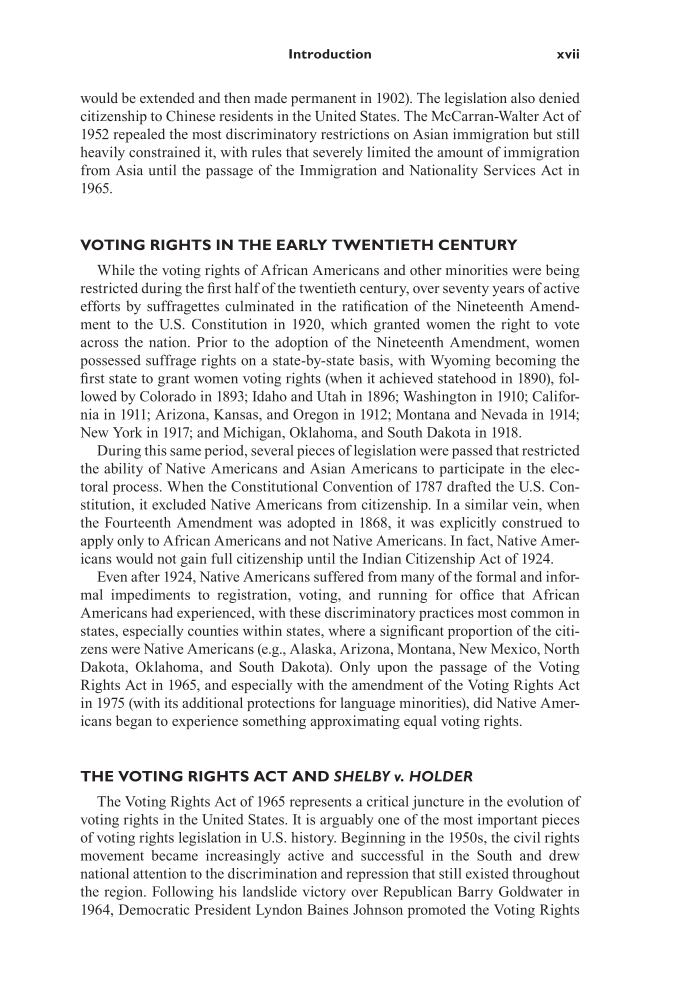Introduction xvii would be extended and then made permanent in 1902). The legislation also denied citizenship to Chinese residents in the United States. The McCarran-Walter Act of 1952 repealed the most discriminatory restrictions on Asian immigration but still heavily constrained it, with rules that severely limited the amount of immigration from Asia until the passage of the Immigration and Nationality Services Act in 1965. VOTING RIGHTS IN THE EARLY TWENTIETH CENTURY While the voting rights of African Americans and other minorities were being restricted during the first half of the twentieth century, over seventy years of active efforts by suffragettes culminated in the ratification of the Nineteenth Amend- ment to the U.S. Constitution in 1920, which granted women the right to vote across the nation. Prior to the adoption of the Nineteenth Amendment, women possessed suffrage rights on a state-by-state basis, with Wyoming becoming the first state to grant women voting rights (when it achieved statehood in 1890), fol- lowed by Colorado in 1893 Idaho and Utah in 1896 Washington in 1910 Califor- nia in 1911 Arizona, Kansas, and Oregon in 1912 Montana and Nevada in 1914 New York in 1917 and Michigan, Oklahoma, and South Dakota in 1918. During this same period, several pieces of legislation were passed that restricted the ability of Native Americans and Asian Americans to participate in the elec- toral process. When the Constitutional Convention of 1787 drafted the U.S. Con- stitution, it excluded Native Americans from citizenship. In a similar vein, when the Fourteenth Amendment was adopted in 1868, it was explicitly construed to apply only to African Americans and not Native Americans. In fact, Native Amer- icans would not gain full citizenship until the Indian Citizenship Act of 1924. Even after 1924, Native Americans suffered from many of the formal and infor- mal impediments to registration, voting, and running for office that African Americans had experienced, with these discriminatory practices most common in states, especially counties within states, where a significant proportion of the citi- zens were Native Americans (e.g., Alaska, Arizona, Montana, New Mexico, North Dakota, Oklahoma, and South Dakota). Only upon the passage of the Voting Rights Act in 1965, and especially with the amendment of the Voting Rights Act in 1975 (with its additional protections for language minorities), did Native Amer- icans began to experience something approximating equal voting rights. THE VOTING RIGHTS ACT AND SHELBY v. HOLDER The Voting Rights Act of 1965 represents a critical juncture in the evolution of voting rights in the United States. It is arguably one of the most important pieces of voting rights legislation in U.S. history. Beginning in the 1950s, the civil rights movement became increasingly active and successful in the South and drew national attention to the discrimination and repression that still existed throughout the region. Following his landslide victory over Republican Barry Goldwater in 1964, Democratic President Lyndon Baines Johnson promoted the Voting Rights
Document Details My Account Print multiple pages
Print
You have printed 0 times in the last 24 hours.
Your print count will reset on at .
You may print 0 more time(s) before then.
You may print a maximum of 0 pages at a time.



























































































































































































































































































































































































































































































































































































































































































































































































































































